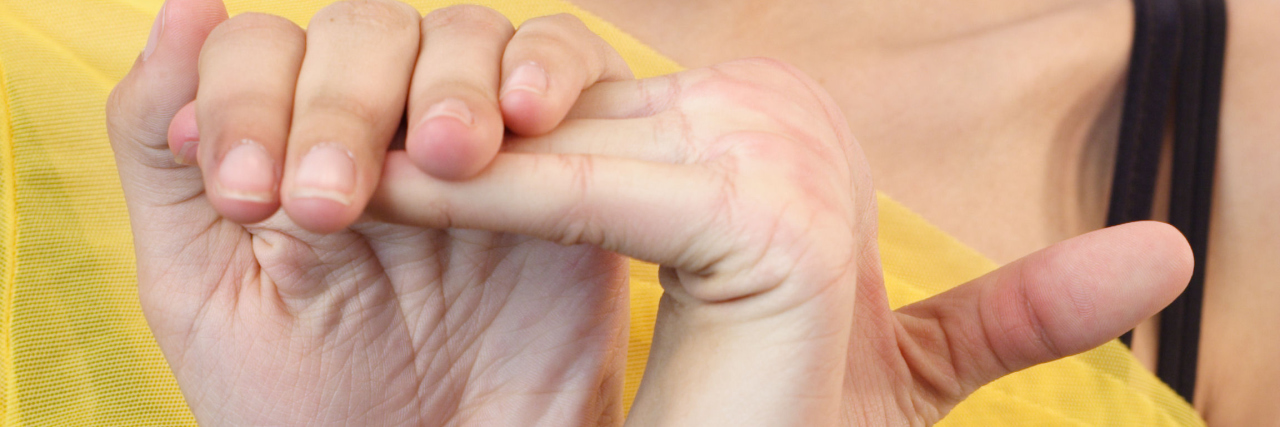If you said the words “joint hypermobility” to someone on the street, chances are their first thoughts would go to double-jointedness, to contortionist yoga poses and showing off hyperextended fingers and elbows as a party trick. That is, if they don’t have hypermobility themselves or know someone who does. For those of us well-acquainted with the condition, we know full well that flexibility, a trait often positioned as something to aim for, can come with a whole load of unexpected, and unwanted, side effects.
Like many chronic conditions, there is a spectrum of severity with hypermobility. For some it is less troublesome, for others it is incredibly debilitating, particularly if it’s a symptom of another condition, such as Ehlers-Danlos syndrome (EDS). I know from my own experience that there’s a lot more to hypermobility than being super flexible – for many, it comes hand-in-hand with pain, disruption and a whole array of symptoms you wouldn’t normally associate with having bendy joints.
It turns out, having atypical collagen affects our lives in many different ways.
For one, it can make tasks that others do without thinking painful or even dangerous. Activities which involve limited or repetitive movement like sitting at a desk, using a computer or driving can cause pain or even chronic injury, as can anything which puts undue pressure on our joints. Those with hypermobility often struggle with bodily awareness, or proprioception, increasing the risk of injury. Before I fully understood it, I suffered injuries and chronic pain from mismanagement of my hypermobility. For me, learning about how my hypermobile body works was the key to managing the symptoms. And, once I knew more about it, I realized there were all sorts of other issues that could be traced back to the condition.
Perhaps one of the more surprising symptoms of hypermobility is that it is often associated with IBS and other digestive issues. While there is a serious lack of research in this area, the link is well-acknowledged, with professionals believing that hypermobility weakens muscles, including the muscles which make the digestive system work, leading to digestive conditions.
People with hypermobility may also have a predisposition to headaches and migraines. It’s all connected to instability in the joints, which can cause poor head posture, which in turn makes the head feel heavier, putting a strain on the head, neck and shoulders. The knock-on effects of this can cause tension, spasms and headaches. Jaw misalignment from hypermobility is also a factor – this causes tension in the jaw muscles which can make talking and eating painful and difficult, as well as trigger further headaches or migraines.
Despite hypermobility often being associated with feeling weak and tired, it can cause a real problem with sleep. There’s always a risk of subluxation, dislocation and pain from moving around while asleep. On top of this, anxiety and fear around the risks of sleeping with hypermobility, being in pain or not being able to get comfortable can all make sleep difficult for hypermobile people. This tension that comes from tiredness and anxiety around sleep can be incredibly disruptive, and cause even more pain and problems with movement. It becomes a vicious and incredibly frustrating cycle.
With all these diverse complications, hypermobility is about much more than being flexible. It’s complicated and disruptive in so many different ways. As a result, it needs careful management, understanding and sympathy.
Understanding and learning to manage hypermobility, like any other chronic condition, is a process. I’ve trained for many years in supporting others with hypermobility and chronic pain, and I’m still learning! To those who are struggling, my recommendation would be to be kind to yourself. Find what works for you and your symptoms, whatever they may include, and work at it. I found my strength through learning, through understanding movement and working on posture and strength. I found it also in support – initially through the support of others, but then through providing support to others.
It might take time, but there is support out there – you can find your strength.
We want to hear your story. Become a Mighty contributor here.
Getty Image by Songbird839

